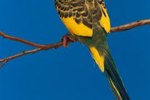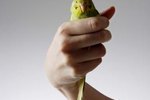
A parrot's beautiful, showy feathers require regular grooming to keep them in top shape and looking their best. Sometimes parrots can become carried away, though, and normal grooming turns into a feather plucking disorder. Careful observation of your bird can help you determine whether he's a fastidious groomer, or participating in obsessive behavior.
A Bird with "Bed Head"
Normal feather grooming keeps a parrot's feathers looking healthy and sleek. They are shiny and well-formed, and lie flat against his body. Feather plucking disorders usually begin as over-preening, so it may be difficult to tell the difference initially. If over-preening occurs, eventually his feathers will look ragged, broken, or otherwise unkempt. Downy feathers should not protrude from beneath the contour feathers, and he should not develop any bald, featherless patches.
Making Sense of Molt
If you observe feather loss from your parrot but do not see him plucking, he may be experiencing a normal condition known as molt. Old feathers wear out and need to be replaced regularly. Your bird will shed the old feathers and new ones will replace them. He may become itchy and groom more than usual, but he should not lose more than one or two feathers from each side of his body at any given time. All birds molt symmetrically, meaning whichever feathers he sheds on one side of his body, he will also shed from the other. This allows him to maintain balanced flight. Birds living outdoors may complete their molt within a month, while indoor birds may stretch it out over an entire year. If you notice an excessive amount of feather loss or patchy feather loss, your parrot may be plucking them.
The Bane of Boredom
Bored birds may resort to feather plucking as a source of entertainment, or as a means of garnering attention. Try to note whether your bird plucks or grooms in your presence, or if he interrupts favorite activities to assault his feathers. A bird engaged in normal grooming will usually not depart from enjoyable activities to groom. If your parrot plucks when you are home but ignoring him, do not scold him for the behavior; rather, ignore it. He may be using plucking as a means to get attention. Ensure you are spending quality time with your bird each day, and refrain from reacting to his plucking. If he is plucking for attention, you will have to ignore him 200 - 300 times before the behavior ceases.
Separation Anxiety and Plucking
Parrots enjoy socializing and do not thrive when lonely. Some types of parrots, such as cockatoos and African greys, are highly emotional and therefore highly susceptible to behavioral disorders when left alone. The emotional stress of being alone may lead a parrot to over-preen, eventually turning into feather plucking. The first 30 minutes after a bird's owner departs are the most crucial. Giving the bird a bath immediately before going out will encourage normal feather grooming and keep him occupied during those first minutes alone. A sufficient supply of toys entertains him and can help ward off self-mutilation.
References
Photo Credits
-
Gary Faber/Digital Vision/Getty Images



